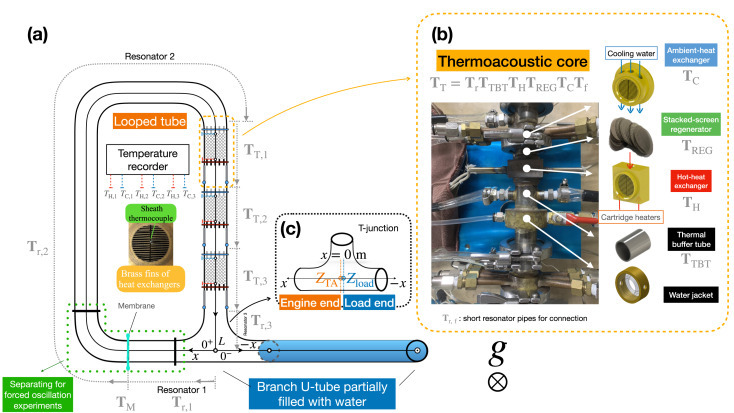Impedance matching for investigating operational conditions in thermoacoustic Stirling fluidyne
This study substitutes the branch resonator’s gas column with a liquid column, significantly reducing and lengthening acoustic wavelengths. It ensures heightened and, crucial for executing the efficient Stirling cycle across multiple regenerators, thereby enhancing the engine’s flexibility for practical applications through dispersed heat input. Our approach employs this novel configuration, termed a thermoacoustic Stirling fluidyne, an acoustical heat engine outputs mechanical power using the liquid piston.

Fig. 1. Schematic drawing of the experimental setup: (a) top view of the thermoacoustic Stirling engine loaded with the liquid piston, (b) the core of the thermoacoustic device, and (c) the T-junction labeled with the engine end and the load end.
Technology Overview
Introducing a flexible design in the fluidyne-style thermoacoustic Stirling engine. Utilization of a vibrating membrane coupled with oscillating liquid columns for improved acoustic modulation. Attainment of remarkably high acoustic impedance, while efficiently preserving the traveling wave phasing within regenerators.
Applications & Benefits
This research offers a novel approach to designing thermoacoustic Stirling fluidyne engines by using liquid columns and membranes to achieve high acoustic impedance with traveling wave phasing. This method significantly improves engine design by accounting for inertance and compliance effects in acoustic field modulation. The concept of acoustic impedance matching allows for precise calibration and enhances analytical estimations, leading to more efficient and powerful thermoacoustic systems. This breakthrough could revolutionize the development of these engines, making them more practical and effective for various applications.
Abstract:
This study investigates acoustic impedance matching between a thermoacoustic Stirling heat engine and a branch liquid column, using multiple regenerators. We characterize acoustic impedances at both the engine and liquid column load ends using thermoacoustic theory, expressed as functions of frequency and temperature differences across regenerators. The intersection points of these functions indicate matched impedances, critical for evaluating the engine’s operating points. Notably, this study emphasizes the impact of a vibrating membrane on the system’s acoustic impedance, highlighting its significant role in modulating acoustic states and facilitating self-sustained oscillations. To verify our theoretical models, we conducted experiments with the proposed fluidyne engine under various liquid column volumes. The verifications confirmed our simple calibrations for characterizing a vibrating membrane clamped in the engine and the oscillating liquid columns. Significantly, the acoustic compliance and inertance effects respectively introduced by the membrane and liquid columns enable us to modulate the engine’s acoustic states. The proposed configuration is named a thermoacoustic Stirling fluidyne. This fluidyne, a heat engine that outputs work power using a liquid piston, achieves a markedly higher acoustic impedance than the pure gas case while maintaining traveling wave phasing for the regenerators.

Impedance matching for investigating operational conditions in thermoacoustic Stirling fluidyne
Author:Shu-Han Hsu, Zhe-Yi Liao
Year:2024
Source publication:Applied Energy, Volume 374, 15 November 2024
Subfield Highest percentage:98% Management, Monitoring, Policy and Law #5 / 406
https://www.sciencedirect.com/science/article/pii/S0306261924013564